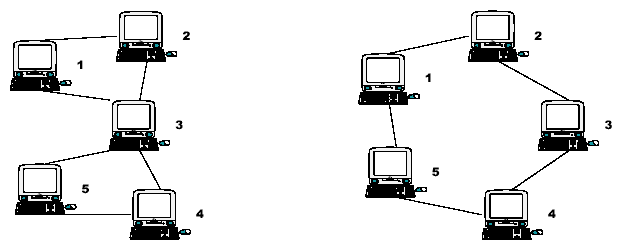POJ 1523 SPF(寻找关节点)
| Time Limit: 1000MS | Memory Limit: 10000K | |
| Total Submissions: 8155 | Accepted: 3730 |
Description
Node 3 is therefore a Single Point of Failure (SPF) for this
network. Strictly, an SPF will be defined as any node that, if
unavailable, would prevent at least one pair of available nodes from
being able to communicate on what was previously a fully connected
network. Note that the network on the right has no such node; there is
no SPF in the network. At least two machines must fail before there are
any pairs of available nodes which cannot communicate.

Input
input will contain the description of several networks. A network
description will consist of pairs of integers, one pair per line, that
identify connected nodes. Ordering of the pairs is irrelevant; 1 2 and 2
1 specify the same connection. All node numbers will range from 1 to
1000. A line containing a single zero ends the list of connected nodes.
An empty network description flags the end of the input. Blank lines in
the input file should be ignored.
Output
The first network in the file should be identified as "Network #1",
the second as "Network #2", etc. For each SPF node, output a line,
formatted as shown in the examples below, that identifies the node and
the number of fully connected subnets that remain when that node fails.
If the network has no SPF nodes, simply output the text "No SPF nodes"
instead of a list of SPF nodes.
Sample Input
1 2
5 4
3 1
3 2
3 4
3 5
0 1 2
2 3
3 4
4 5
5 1
0 1 2
2 3
3 4
4 6
6 3
2 5
5 1
0 0
Sample Output
Network #1
SPF node 3 leaves 2 subnets Network #2
No SPF nodes Network #3
SPF node 2 leaves 2 subnets
SPF node 3 leaves 2 subnets
#include <iostream>
#include <cstring>
#include <cstdio>
#include <algorithm>
#include <cmath>
#include <string>
#include <map>
#include <queue>
#include <vector>
#define inf 0x7fffffff
#define met(a,b) memset(a,b,sizeof a)
typedef long long ll;
using namespace std;
const int N = ;
const int M = ; int edg[N][N],vis[N];
int nodes,tmpdfn,son;
int dfn[N],low[N],subnets[N];
void init()
{
low[]=dfn[]=;
tmpdfn=;son=;
met(vis,);met(subnets,);
vis[]=;
}
void Tarjan(int u)
{
for(int v=;v<=nodes;v++){
if(edg[u][v]){
if(!vis[v]){
vis[v]=;
dfn[v]=low[v]=++tmpdfn;
Tarjan(v);
low[u]=min(low[u],low[v]);
if(low[v]>=dfn[u]){
if(u!=)subnets[u]++;
else son++;
}
}
else low[u]=min(low[u],dfn[v]);
}
}
}
int main()
{
int u,v,num=;
while(~scanf("%d",&u)&&u){
met(edg,);nodes=;
scanf("%d",&v);
nodes=max(max(u,v),nodes);
edg[u][v]=edg[v][u]=;
while(){
scanf("%d",&u);
if(!u)break;
scanf("%d",&v);
nodes=max(max(u,v),nodes);
edg[u][v]=edg[v][u]=;
}
if(num>)printf("\n");
printf("Network #%d\n",num);num++;
init();
Tarjan();
if(son>)subnets[]=son-;
bool find=false;
for(int i=;i<=nodes;i++){
if(subnets[i]){
find=true;printf(" SPF node %d leaves %d subnets\n",i,subnets[i]+);
}
}
if(!find)printf(" No SPF nodes\n");
}
return ;
}
POJ 1523 SPF(寻找关节点)的更多相关文章
- poj 1523 SPF(双连通分量割点模板)
题目链接:http://poj.org/problem?id=1523 题意:给出无向图的若干条边,求割点以及各个删掉其中一个割点后将图分为几块. 题目分析:割点用tarjan算法求出来,对于每个割点 ...
- zoj 1119 / poj 1523 SPF (典型例题 求割点 Tarjan 算法)
poj : http://poj.org/problem?id=1523 如果无向图中一个点 u 为割点 则u 或者是具有两个及以上子女的深度优先生成树的根,或者虽然不是一个根,但是它有一个子女 w, ...
- POJ 1523 SPF 割点与桥的推断算法-Tarjan
题目链接: POJ1523 题意: 问一个连通的网络中有多少个关节点,这些关节点分别能把网络分成几部分 题解: Tarjan 算法模板题 顺序遍历整个图,能够得到一棵生成树: 树边:可理解为在DFS过 ...
- POJ 1523 SPF tarjan求割点
SPF Time Limit: 1000MS Memory Limit ...
- POJ 1523 SPF(求割点)
题目链接 题意 : 找出图中所有的割点,然后输出删掉他们之后还剩多少个连通分量. 思路 : v与u邻接,要么v是u的孩子,要么u是v的祖先,(u,v)构成一条回边. //poj1523 #includ ...
- POJ 1523 SPF (割点,连通分量)
题意:给出一个网络(不一定连通),求所有的割点,以及割点可以切分出多少个连通分量. 思路:很多种情况. (1)如果给的图已经不是连通图,直接“ No SPF nodes”. (2)求所有割点应该不难 ...
- zoj 1119 /poj 1523 SPF
题目描述:考虑图8.9中的两个网络,假定网络中的数据只在有线路直接连接的2个结点之间以点对点的方式传输.一个结点出现故障,比如图(a)所示的网络中结点3出现故障,将会阻止其他某些结点之间的通信.结点1 ...
- POJ - 1523 SPF
题目要求割顶集,并且还要求出去掉割顶之后剩下的图连通数目. tarjan算法求出割顶后直接枚举就可以了吧. 一开始想到利用iscut[u]的次数也就是点u被判定为割顶的次数求连通分量数,还有利用与结点 ...
- poj 1523 SPF【点双连通求去掉割点后bcc个数】
SPF Time Limit: 1000MS Memory Limit: 10000K Total Submissions: 7246 Accepted: 3302 Description C ...
随机推荐
- 根据窗体自动调整控件及文本框记住上次填写内容Demo
第一次写文章,组词难免没有不通之处... 最近常用到Winform根据窗体大小自动调整空间大小及字体.文本框记住上次填写内容待下次输入某一段时候自动跳出上次输入内容.于是就随便把两个问题放到同一个de ...
- zoj 3228 覆盖及非覆盖串的多次匹配
题目题意: 给定多个小串,在一个长串中寻找这些串的匹配次数,有些统计的是可覆盖的,有些统计的是非覆盖的 先可以简单理解一下,建立ac自动机后,当前节点包含的字符串必然被把它作为fail指针的节点包含, ...
- HDU 4548
题意: 给你一个区间,问你这个区间中的数既是素数又是美素数的数有多少个?美素数:首先这个数本身必须是素数并且它的各位数字的和也是素数; 如29,本身是素数, 而且2+9 = 11也是素数, 所以它是美 ...
- android 录音的断点续传
系统没有暂停的功能 只能把每次的录音进行拼接... package com.example.zrecord; import java.io.File;import java.io.FileInput ...
- Linux下备份系统至另一硬盘
首先会想到dd命令. 但,, 1,若是小硬盘还好,上T的大硬盘这样做肯定不明智; 2,况且dd是在硬件层面的拷贝,前面的MBR也会随之恢复到另一个盘,若源硬盘是100G,目标盘是200G,又会出问题, ...
- AFNETWorking3.x实战教程
上一篇文章介绍了优秀的第三方网络请求框架AFNETWorking2.0,本篇就通过一个实战例子来总结AFNetworking的使用. 本文参考http://www.raywenderlich.com/ ...
- ODI中查看变更及对象查找
ODI中可以查看每个对象的修改时间.修改人,当ETL作业失败之后,可以根据这些信息了解到是否有人修改过相关的对象. 另外,在ODI的菜单项中,也可以查看按修改时间.人员等搜索指定的对象,如查找最近7天 ...
- zoj1610 线段树
//Accepted 804 KB 40 ms //整个题,都是坑 //1.The first line of each data set contains exactly one integer n ...
- (转)Document对象内容集合
原文:http://webcenter.hit.edu.cn/articles/2009/06-10/06144703.htm document 文挡对象 - JavaScript脚本语言描述 ——— ...
- compare:(字符串的大小比较)
1.字符串的比较是按照ascall码进行比较的 比如A比a的值小, if([string1 compare:string2] == (以下描述)) 如果比较的结果是NSOrderedDescendin ...
